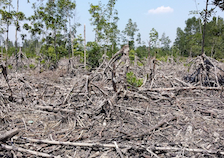The findings are results yielded from their research of ecosystem ecology of coastal wetlands. Previous studies have suggested that Blue Carbon, carbon stored in mangroves and other marine wetlands such as saltmarshes and seagrass beds from coastal ecosystems, holds three to five times higher of carbon density than carbon stored in forests and grasslands.
Following such direction, the research team combined data from past studies and new field measurements of sediments in tidal wetlands in different countries, as well as took account of components which were neglected in past studies, and an underestimate of 23% of carbon stocked in mangrove forests is recorded. The correction of bias on carbon density estimation in tidal wetlands spells out the urgency of tidal wetland resources conservation as Blue Carbon helps capture carbon dioxide and reduces the impact of greenhouse effect, resulting in a cooler Earth. The research findings have been published in influential scientific journal Nature Communications.
Further reading:
Ouyang, X., & Lee, S. Y. (2020). Improved estimates on global carbon stock and carbon pools in tidal wetlands. Nature Communications, 11(1), 1-7. DOI: https://doi.org/10.1038/s41467-019-14120-2
University Press Release













